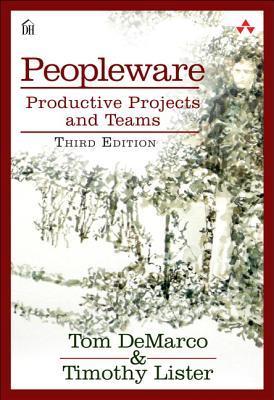the best books for developers

Topics: Project Management, Team Building, Corporate Culture, Hiring
By Tom DeMarco, Timothy Lister
9780321934116
"Peopleware" by Tom DeMarco and Timothy Lister is like the ultimate guide to making your workplace awesome. This book isn't about fancy software or cutting-edge technology; it's about the people who make projects happen.
First, it dives into the importance of a great work environment. You'll learn why those comfy chairs and quiet spaces actually matter and how they can boost productivity and creativity.
Then, it delves into the mysteries of team dynamics. You'll find out why some teams rock while others flop, and how to build a team that's more Avengers than dysfunctional family.
Meetings often feel like a necessary evil, but "Peopleware" shows you how to make them worthwhile and not soul-draining. You'll learn the art of productive meetings that actually lead to decisions and action.
But it doesn't stop there; the book uncovers the dark side of crunch time. You'll see how overtime and long hours can actually kill creativity and productivity, and why it's important to protect your team's personal time.
Communication is another gem in this book. You'll discover the power of information flow, and how it can make or break a project. Hint: it's all about sharing, trust, and openness.
And don't forget the "jelled team" – a group of people who just click. You'll learn how to foster that magic chemistry and create teams that achieve the extraordinary.
Finally, the book talks about the big picture – how organizations should be designed to support creative work, not hinder it. You'll explore topics like the Peter Principle and how to build a culture of excellence.
In a nutshell, "Peopleware" is like a recipe book for creating a workplace where people thrive, teams excel, and projects succeed. It's not just about software development; it's about making work a place where you'd actually want to be.
Chapter 1: The Hungry Chicken and Other Tales
In the opening chapter, the authors introduce the concept that the most critical elements in software development are people and their interactions. They emphasize the importance of creating an environment where teams can thrive and be productive, setting the tone for the book's exploration of human-centric approaches to project management.
Chapter 2: Demolition Derby
Chapter 2 discusses the destructive impact of excessive pressure and unreasonable deadlines on project teams. The authors highlight how the Jelled Team can be disrupted by these pressures, leading to decreased morale, creativity, and productivity. They advocate for a healthier work-life balance and a focus on sustainable productivity.
Chapter 3: Quality
Quality is the central theme of this chapter, where the authors delve into the factors that contribute to software quality. They emphasize the need for a shared commitment to quality within the team and the organization, stressing that quality should not be compromised for the sake of speed.
Chapter 4: The Office Environment
In this chapter, the authors explore the physical workspace and its impact on productivity. They discuss the importance of a comfortable and well-designed office environment, where individuals can focus on their work and collaborate effectively. The chapter also addresses the significance of private, uninterrupted space for deep thinking.
Chapter 5: Programming Projects from Hell
Chapter 5 recounts stories of dysfunctional projects and their common characteristics. The authors dissect what can go wrong in software development projects, from poor communication to unrealistic expectations. They stress the need for strong leadership and effective management to prevent projects from descending into chaos.
Chapter 6: Quality, Productivity, and the Risky Business of Process Improvement
This chapter explores the relationship between process improvement and software development productivity. The authors discuss how a focus on process improvement can enhance both quality and productivity, provided that it is approached with care and sensitivity to the needs of the team.
Chapter 7: Sociopaths, Heroes, and Clueless Bastards
Chapter 7 delves into the dynamics of team composition and how the presence of certain personalities can affect team performance. The authors categorize team members into different archetypes and provide insights into managing these diverse personalities to create cohesive and productive teams.
Chapter 8: Communication Pitfalls
Communication is a central theme of this chapter, which explores the challenges and pitfalls that can hinder effective information flow within teams. The authors provide guidance on fostering open and honest communication and stress the importance of trust as a foundation for effective collaboration.
Chapter 9: The Telephone Game
In this chapter, the authors discuss the phenomenon of information distortion that can occur within organizations. They emphasize the need for clear and direct communication to prevent misunderstandings and distortions as information passes through various layers of management.
Chapter 10: Astonishing Conversions
Chapter 10 focuses on the potential for remarkable transformations within organizations. The authors share stories of organizations that have successfully implemented people-centric approaches to project management and reaped the rewards of increased productivity and morale.
Chapter 11: Professionalism and the Maverick Programmer
The final chapter addresses the tension between individualism and professionalism in software development. The authors advocate for a balance between allowing talented individuals to flourish while maintaining a professional and collaborative team environment. They emphasize the importance of professionalism and ethical behavior in the industry.